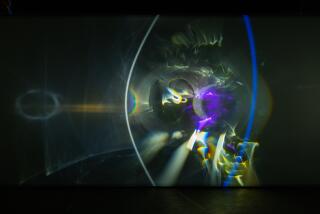Iranian artist Pouya Afshar’s ‘En Masse’ is a meditation on mourning
- Share via
Pouya Afshar, an Iranian artist who grew up in Tehran, was an undergraduate student studying animation at CalArts. Leo Hobaica Jr. was his color-and-design class professor.
But more than that, Hobaica was a mentor and a friend — someone who gave his time and guidance to help Afshar navigate life in America and life as an artist.
So it was devastating to Afshar, personally and creatively, when three years ago Hobaica died from cancer.
Afshar channeled his grief into his art. He created paintings, charcoal drawings, animated videos and delicate sculptures addressing birth, death, the charged but ephemeral nature of creativity and the subjectivity (and ultimate disintegration) of memory.
Afshar’s work will be part of a Los Angeles County Museum of Art exhibition in May. But first he has the solo show “En Masse” at the Space by Advocartsy in downtown L.A., where 15 works are centered on mourning.
“Leo’s loss made me vulnerable,” he said in a recent interview for this edited Q&A. “This was a beginning for me to climb out of my shell, to grow and to empathize.”
Much of your work draws on Persian and Muslim Shiite mourning rituals, called Ta’zie, which unfold almost like community theater. Can you elaborate on the connection between these rituals and your art?
Having grown up in Iran, my work is informed by traditions and rituals. I materialize these traditions through art. [In the animation short “En Masse”] the process of transformation is as equally substantial to me as the product itself. How I, as a mentee, am advised by my environment … plays an integral part.
The nature of Ta’zie is very similar to this process. Ta’zie occupies the audience emotionally and lets them react in a naive way. The audience is engaged in the performance and will experience changing roles as the narrative unfolds. People who attend these rituals are experiencing them not only as art but as a communal tool to ease challenges. It lets them complement life’s difficulties and grow by being vulnerable to their feelings. They can let go in a play and hide between their role, as audience. The same happens for the actors of Ta’zie who are usually amateur artists.
How is “En Masse” related to another piece of yours, “Mourn Baby Mourn,” that will show at LACMA as part of “In the Fields of Empty Days: The Intersection of Past and Present in Iranian Art”?
“Mourn Baby Mourn” is the title of the original piece in which the story of Ashoura unfolds in a narrative manner. “Mourn Baby Mourn” sets up a virtual theater within a tent, chasing a young boy (representing myself) witnessing the events of Karbala while he carries a sculpture made by Leo. The video maneuvers between imagination reality and melancholy. What I am presenting with “En Masse” is a more representational view of Ta’zie while “Mourn Baby Mourn” depicts a personal journey.
So much of your work is about the nature of memory — and the disintegration of it, especially when it comes to recalling the faces of loved ones. Why?
The notion of recollection symbolizes the particles within one’s imagination that form our memories. When we remember a loved one, we don’t just visualize an image. We recall several tangible elements from our perception about that person. Even with objects, if we spend some time with one, we develop sympathy towards that object. We collect data when in the presence of someone or something and store them based on our observation. The interesting thing is that this data constantly changes in form, shape, texture and meaning in our mind. If we come to the conclusion that we cannot access that thing or person for good, our mind starts to manipulate the data in a way that we can cope with the void. What I’m doing is materializing this process through image-making and recycling memories.
Your series of hanging works, “Memories Layered,” are intricate sculptures that you call 2.5-D works rather than 3-D works. Why?
I refer to these pieces as 2.5-D because they are fluid in depth and not entirely registered on that dimension. That’s how I feel about memories. What are memories without time? Or without space?
In a sense, depth acts as time here for me. When two people meet in a certain time and a certain place, they create a connection that solidifies based on their perception of each other. If we change any of those two factors, time and space, the quality of that connection changes. If the audience moves around these pieces, their perception of what they see also changes, so their connection to that piece changes too.
How are the reflections and shadows they cast as important a part of the work as the delicately inked acetate sheets themselves?
The outcome of this clash between time and space is translated on the wall [through shadows] as images that can change if the lighting changes.
I always think to myself: “How would my relationship with Leo be if I met him at a different time, in a different setup? How would it change my perception of him and vice versa?” This thought helps me be aware of how I treat my own students and the connections we make.
♦ ♦ ♦ ♦ ♦ ♦ ♦ ♦ ♦ ♦
Where: The Space by Advocartsy, 924 S. San Pedro St., L.A.
When: Through Sunday
Information: (213) 372-5096, www.advocartsy.com
Follow me on Twitter: @debvankin
ALSO
What’s next for the Getty’s Pacific Standard Time? This critic has an idea
What’s that shower being wheeled around the city? It’s the PST festival for performance art
More to Read
The biggest entertainment stories
Get our big stories about Hollywood, film, television, music, arts, culture and more right in your inbox as soon as they publish.
You may occasionally receive promotional content from the Los Angeles Times.











